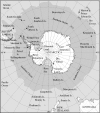Evolution and biodiversity of Antarctic organisms: a molecular perspective
- PMID: 17553774
- PMCID: PMC2443175
- DOI: 10.1098/rstb.2006.1948
Evolution and biodiversity of Antarctic organisms: a molecular perspective
Abstract
The Antarctic biota is highly endemic, and the diversity and abundance of taxonomic groups differ from elsewhere in the world. Such characteristics have resulted from evolution in isolation in an increasingly extreme environment over the last 100 Myr. Studies on Antarctic species represent some of the best examples of natural selection at the molecular, structural and physiological levels. Analyses of molecular genetics data are consistent with the diversity and distribution of marine and terrestrial taxa having been strongly influenced by geological and climatic cooling events over the last 70 Myr. Such events have resulted in vicariance driven by continental drift and thermal isolation of the Antarctic, and in pulses of species range contraction into refugia and subsequent expansion and secondary contact of genetically distinct populations or sister species during cycles of glaciation. Limited habitat availability has played a major role in structuring populations of species both in the past and in the present day. For these reasons, despite the apparent simplicity or homogeneity of Antarctic terrestrial and marine environments, populations of species are often geographically structured into genetically distinct lineages. In some cases, genetic studies have revealed that species defined by morphological characters are complexes of cryptic or sibling species. Climate change will cause changes in the distribution of many Antarctic and sub-Antarctic species through affecting population-level processes such as life history and dispersal.
Figures


Similar articles
-
Introduction. Antarctic ecology: from genes to ecosystems. Part 2. Evolution, diversity and functional ecology.Philos Trans R Soc Lond B Biol Sci. 2007 Dec 29;362(1488):2187-9. doi: 10.1098/rstb.2007.2135. Philos Trans R Soc Lond B Biol Sci. 2007. PMID: 17553772 Free PMC article.
-
Proceedings of the SMBE Tri-National Young Investigators' Workshop 2005. Southern hemisphere springtails: could any have survived glaciation of Antarctica?Mol Biol Evol. 2006 May;23(5):874-82. doi: 10.1093/molbev/msj073. Epub 2005 Dec 2. Mol Biol Evol. 2006. PMID: 16326749
-
Ocean barriers and glaciation: evidence for explosive radiation of mitochondrial lineages in the Antarctic sea slug Doris kerguelenensis (Mollusca, Nudibranchia).Mol Ecol. 2009 Mar;18(5):965-984. doi: 10.1111/j.1365-294X.2008.04071.x. Mol Ecol. 2009. PMID: 19207248
-
The adaptation of polar fishes to climatic changes: Structure, function and phylogeny of haemoglobin.IUBMB Life. 2008 Jan;60(1):29-40. doi: 10.1002/iub.1. IUBMB Life. 2008. PMID: 18379990 Review.
-
Environmental constraints on life histories in Antarctic ecosystems: tempos, timings and predictability.Biol Rev Camb Philos Soc. 2006 Feb;81(1):75-109. doi: 10.1017/S1464793105006871. Epub 2005 Nov 17. Biol Rev Camb Philos Soc. 2006. PMID: 16293196 Review.
Cited by
-
Molecular Evolution and Adaptation Strategies in Marine Ciliates: An Inspiration for Cold-Adapted Enzyme Engineering and Drug Binding Analysis.Mar Drugs. 2024 Nov 4;22(11):497. doi: 10.3390/md22110497. Mar Drugs. 2024. PMID: 39590777 Free PMC article. Review.
-
Diversity and distribution patterns in high southern latitude sponges.PLoS One. 2012;7(7):e41672. doi: 10.1371/journal.pone.0041672. Epub 2012 Jul 24. PLoS One. 2012. PMID: 22911840 Free PMC article.
-
Genetic population structure in the Antarctic benthos: insights from the widespread amphipod, Orchomenella franklini.PLoS One. 2012;7(3):e34363. doi: 10.1371/journal.pone.0034363. Epub 2012 Mar 27. PLoS One. 2012. PMID: 22479613 Free PMC article.
-
Antarctic strict anaerobic microbiota from Deschampsia antarctica vascular plants rhizosphere reveals high ecology and biotechnology relevance.Extremophiles. 2016 Nov;20(6):875-884. doi: 10.1007/s00792-016-0878-y. Epub 2016 Oct 5. Extremophiles. 2016. PMID: 27709303
-
Facilitating population genomics of non-model organisms through optimized experimental design for reduced representation sequencing.BMC Genomics. 2021 Aug 21;22(1):625. doi: 10.1186/s12864-021-07917-3. BMC Genomics. 2021. PMID: 34418978 Free PMC article.
References
-
- Adam K.D, Selkirk P.M, Connett M.B, Walsh S.M. Genetic variation in populations of the moss Bryum argenteum in East Antarctica. In: Battaglia B, Valencia J, Walton D.W.H, editors. Antarctic communities. Cambridge University Press; Cambridge, UK: 1997. pp. 33–38.
-
- Adcock G.J, Shaw P.W, Rodhouse P.G, Carvalho G.R. Microsatellite analysis of genetic diversity in the squid Illex argentinus during a period of intensive fishing. Mar. Ecol. Prog. Ser. 1999;187:171–178.
-
- Ainley D.G, DeMaster D.P. Survival and mortality in a population of Adélie penguins. Ecology. 1980;61:522–530. doi:10.2307/1937418 - DOI
-
- Allcock A.L, Piertney S.B. Evolutionary relationships of Southern Ocean Octopodidae (Cephalopoda: Octopoda) and a new diagnosis of Pareledone. Mar. Biol. 2002;140:129–135. doi:10.1007/s002270100687 - DOI
-
- Allcock A.L, Brierley A.S, Thorpe J.P, Rodhouse P.G. Restricted gene flow and evolutionary divergence between geographically separated populations of the Antarctic octopus Pareledone turqueti. Mar. Biol. 1997;129:97–102. doi:10.1007/s002270050150 - DOI
MeSH terms
LinkOut - more resources
Full Text Sources
Miscellaneous

